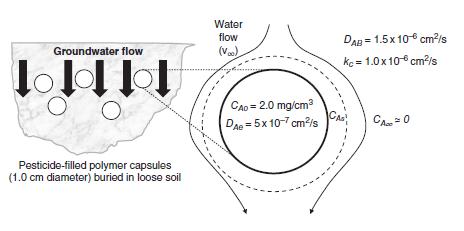A spherical time-release capsule was developed to release pesticide to surrounding soil, as shown in the figure
Question:
A spherical time-release capsule was developed to release pesticide to surrounding soil, as shown in the figure below. The capsule is 1.0 cm in diameter, and is made of a polymer containing a uniform initial concentration of pesticide (species A) equal to 2.0 mg/cm3. The effective diffusion coefficient (DAe) of the pesticide in the polymer is 5.0 x 10-7 cm2/s. During wet periods of the year, water flows into the loose soil and slowly flows around the buried capsules, creating a boundary layer that provides a convective mass transfer coefficient (kc) of about 1.0 10-6 cm/s. The bulk concentration of pesticide in the flowing water is very small, and so can be considered as effectively equal to zero (cA∞ ≈ 0). The molecular diffusion coefficient of the pesticide in the water (DAB) is 1.5 X 10-6 cm2/s (A = pesticide, B = water).
a. What is the concentration of pesticide in the center of the capsule after a time of 173.6 h?
b. What is the concentration of pesticide at the surface (r = R) of the capsule after 173.6 h, and what is the flux of pesticide out of the particle, NA(R,t), at this time, in units of mg/cm2s?

Step by Step Answer:

Fundamentals Of Momentum Heat And Mass Transfer
ISBN: 9781119723547
7th Edition
Authors: James Welty, Gregory L. Rorrer, David G. Foster





